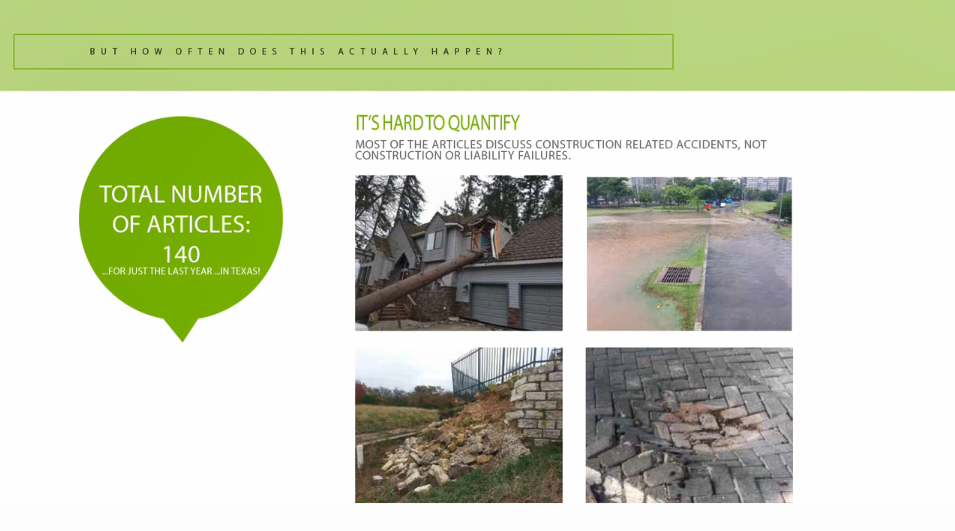The work of landscape architects work involves complex decisions and responsibilities — detailing and designing projects, observing construction, achieving owner satisfaction, and ensuring the health, safety, and welfare of the public. Landscape architects are subject to professional liability as a direct result of the higher expectations placed on us due to our specialized education and training. When a project doesn’t go according to plan, owners can file lawsuits against the design firm. Risk are inherent in the landscape architecture profession, but we rarely talk about it. During the Land8x8 Lightning Talks in Austin, TX, Marissa McKinney, Principal at Austin-based landscape architecture firm Coleman & Associates, discussed the many ways in which design professionals expose themselves to legal liability and how design firms can mitigate risk.
Analyze Risk
Risk management should begin before a contract is even signed. To reduce unforeseen problems, it is important to identify potential risks early on, and analyze the risk’s potential impact and its likelihood of occurring. Before taking on a new project type or working with a new client, as yourself “is it worth the risk?”. By planning a risk response and implementing it, you avoid, minimize, and/or accept the risk.
Set Owner Expectations
Professional liability claims are often a result of a failure to manage expectations. A well-written contract is the first step to reduce liability, and is the best way to set both parties’ expectations on a project. It sets a clear understanding between the client and designer of the landscape architect’s scope of work, and the quality and timing of the final product. A contract allows both parties to clearly document their mutual understanding for project requirements and obligations, which should reduce the likelihood of a later dispute. Poorly written contracts and ambiguous language can expose firms to unintended risks. While standard contract forms, such as those provided by ASLA, are a useful first step, getting legal review of standard contracts is another important assurance.
Communication is Key
When unexpected schedule delays or cost overruns occur, communication to the client is key. Lack of communication may result in a big – and often costly – surprise later for the client. Make sure that the contract details all the terms of your work – including deliverables, deadlines, and pay rates – so both parties have everything in writing. If a project’s scope changes or you take on more responsibilities, it’s a good idea to modify and re-sign the contract so that these changes are spelled out and can be covered should something go awry. Regularly check in with the client throughout the project so that you can manage expectations and stay aware of new or shifting priorities. Be proactive by taking and distributing comprehensive meeting notes and getting direction in writing to prevent disputes later on.
Practice Standard of Care
Although landscape architects strive for perfection in their work, errors happen. Most mistakes are caused by the complexity of the design coupled with human limitations – i.e. a code requirement might be over-looked or dimension miscalculated. By using the standard of care clause, professionals can protect themselves from liability if the issue of negligence should arise. Under this standard, the design professional is held to use the same degree of care as is ordinarily practices by other reasonably competent landscape architects. The standard of care sets realistic expectations; however, it is typically the responsibility of the landscape architect to perform quality control of their drawings, ensure drawings are properly coordinated between consultants, and review bidding documents for compliance with client instructions, regulatory code, and other requirements. However, landscape architects routinely do not guarantee construction outcomes because they are not capable of making those guarantees come true.
Reduce Responsibility
Much of the risk occurs during construction. A landscape architect’s approach to construction administration can greatly affect risk exposure and its outcomes. Contractors are your first line of dense in flagging potential errors. Encourage them to ask about suspected errors and omissions and respond quickly to their requests to set a pace for a constructive dialogue in the future. The landscape architect should also conduct site visits to ensure construction quality. Should potentially costly decisions need to be made, reduce liability by allowing the client to make those hard decisions. Unfortunately, the design firm is not always contracted to perform construction observation services, or an exhausted fee limits their ability to control liabilities. For this reason, clear expectations and an understanding of responsibility are again vital.
Depending on the contract language, the landscape architecture practice can be held liable for the negligence of contractors or sub-consultants working on a project. Even if you’ve detailed and specified suitable materials, there is no guarantee that the construction project manager will follow your instructions or that you will be made aware of substitutions. If there are flaws in the finished product due to construction mistakes, the owner could sue the landscape architect for negligence and hold them liable for damages. Similarly, McKinney shares an example of a practitioner who included the structural engineer’s mark-ups of a retaining wall within their landscape architecture drawings. When the wall failed, the client held the landscape architect responsible despite the mistake being caused by the sub-consultant. It is important that you avoid accepting responsibility for other people’s negligent acts. One way to do so is through the use of an indemnity clause. Indemnity is an agreement to assume a specific liability in the event of a loss, shifting risk from one party to another.

Emerging / Specialized Risks
Today, landscape architecture projects are expected to mitigate climate change and respond to a host of constantly evolving future variables. As projects become more complicated and require specialized expertise to achieve desired environmental outcomes, the risk landscape architects face is heightened. Similarly, complicated projects require more customized details and increase liability. Practitioners should expect proper compensation for taking on such risks, while also protecting themselves from undue liability by ensuring they are up-to-date on latest practices, curating a sub-consultant team of knowledgeable experts, and managing client expectations.
Liability Insurance
To protect against expensive lawsuits, most landscape architecture and design businesses carry professional liability insurance, also known as errors and omissions insurance. These policies protect the firm and its employees from lawsuits caused by poor communication, changing project requirements, negligent acts, errors or omissions in the performance of a service, and budget overruns. Professional liability insurance provides coverage for legal costs to defend against a claim. Additionally, insurers offer ongoing risk management services to insured firms, including legal review of standard contracts, and continuing education on ways to reduce or avoid unnecessary liability.
Proper risk management strengthens client confidence, increase profitability, and ensures a high quality of services rendered. We must take the necessary steps to protect ourselves and mitigate risk. During her presentation, McKinney stated that the profession as a whole does not put enough emphasis on professional practice, and urged professionals to talk openly about their own experiences, continually elevating the risk management standards not only of their own practice, but of the professional as a whole. Do you have risk management advice based on issues you’ve run into? Share it in the comments section below!
—
This video was filmed on June 25, 2019 in Austin, TX as part of the Land8x8 Lighting Talks sponsored by Anova Furnishings.
Published in Blog, Cover Story, Featured












